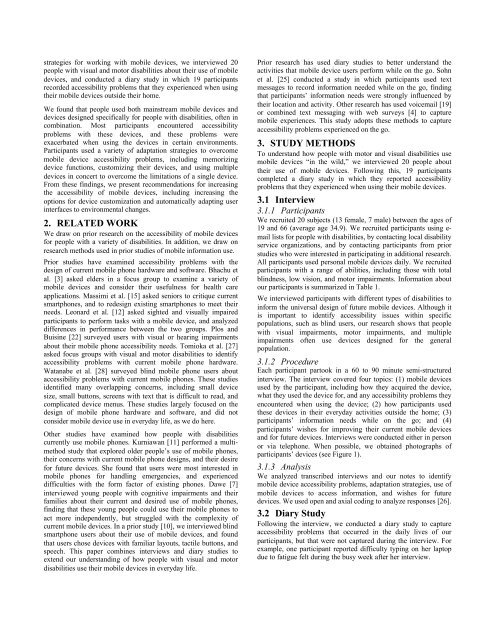Freedom to Roam: A Study of Mobile Device Adoption and - UMBC
Freedom to Roam: A Study of Mobile Device Adoption and - UMBC
Freedom to Roam: A Study of Mobile Device Adoption and - UMBC
Create successful ePaper yourself
Turn your PDF publications into a flip-book with our unique Google optimized e-Paper software.
strategies for working with mobile devices, we interviewed 20<br />
people with visual <strong>and</strong> mo<strong>to</strong>r disabilities about their use <strong>of</strong> mobile<br />
devices, <strong>and</strong> conducted a diary study in which 19 participants<br />
recorded accessibility problems that they experienced when using<br />
their mobile devices outside their home.<br />
We found that people used both mainstream mobile devices <strong>and</strong><br />
devices designed specifically for people with disabilities, <strong>of</strong>ten in<br />
combination. Most participants encountered accessibility<br />
problems with these devices, <strong>and</strong> these problems were<br />
exacerbated when using the devices in certain environments.<br />
Participants used a variety <strong>of</strong> adaptation strategies <strong>to</strong> overcome<br />
mobile device accessibility problems, including memorizing<br />
device functions, cus<strong>to</strong>mizing their devices, <strong>and</strong> using multiple<br />
devices in concert <strong>to</strong> overcome the limitations <strong>of</strong> a single device.<br />
From these findings, we present recommendations for increasing<br />
the accessibility <strong>of</strong> mobile devices, including increasing the<br />
options for device cus<strong>to</strong>mization <strong>and</strong> au<strong>to</strong>matically adapting user<br />
interfaces <strong>to</strong> environmental changes.<br />
2. RELATED WORK<br />
We draw on prior research on the accessibility <strong>of</strong> mobile devices<br />
for people with a variety <strong>of</strong> disabilities. In addition, we draw on<br />
research methods used in prior studies <strong>of</strong> mobile information use.<br />
Prior studies have examined accessibility problems with the<br />
design <strong>of</strong> current mobile phone hardware <strong>and</strong> s<strong>of</strong>tware. Bhachu et<br />
al. [3] asked elders in a focus group <strong>to</strong> examine a variety <strong>of</strong><br />
mobile devices <strong>and</strong> consider their usefulness for health care<br />
applications. Massimi et al. [15] asked seniors <strong>to</strong> critique current<br />
smartphones, <strong>and</strong> <strong>to</strong> redesign existing smartphones <strong>to</strong> meet their<br />
needs. Leonard et al. [12] asked sighted <strong>and</strong> visually impaired<br />
participants <strong>to</strong> perform tasks with a mobile device, <strong>and</strong> analyzed<br />
differences in performance between the two groups. Plos <strong>and</strong><br />
Buisine [22] surveyed users with visual or hearing impairments<br />
about their mobile phone accessibility needs. Tomioka et al. [27]<br />
asked focus groups with visual <strong>and</strong> mo<strong>to</strong>r disabilities <strong>to</strong> identify<br />
accessibility problems with current mobile phone hardware.<br />
Watanabe et al. [28] surveyed blind mobile phone users about<br />
accessibility problems with current mobile phones. These studies<br />
identified many overlapping concerns, including small device<br />
size, small but<strong>to</strong>ns, screens with text that is difficult <strong>to</strong> read, <strong>and</strong><br />
complicated device menus. These studies largely focused on the<br />
design <strong>of</strong> mobile phone hardware <strong>and</strong> s<strong>of</strong>tware, <strong>and</strong> did not<br />
consider mobile device use in everyday life, as we do here.<br />
Other studies have examined how people with disabilities<br />
currently use mobile phones. Kurniawan [11] performed a multimethod<br />
study that explored older people’s use <strong>of</strong> mobile phones,<br />
their concerns with current mobile phone designs, <strong>and</strong> their desire<br />
for future devices. She found that users were most interested in<br />
mobile phones for h<strong>and</strong>ling emergencies, <strong>and</strong> experienced<br />
difficulties with the form fac<strong>to</strong>r <strong>of</strong> existing phones. Dawe [7]<br />
interviewed young people with cognitive impairments <strong>and</strong> their<br />
families about their current <strong>and</strong> desired use <strong>of</strong> mobile phones,<br />
finding that these young people could use their mobile phones <strong>to</strong><br />
act more independently, but struggled with the complexity <strong>of</strong><br />
current mobile devices. In a prior study [10], we interviewed blind<br />
smartphone users about their use <strong>of</strong> mobile devices, <strong>and</strong> found<br />
that users chose devices with familiar layouts, tactile but<strong>to</strong>ns, <strong>and</strong><br />
speech. This paper combines interviews <strong>and</strong> diary studies <strong>to</strong><br />
extend our underst<strong>and</strong>ing <strong>of</strong> how people with visual <strong>and</strong> mo<strong>to</strong>r<br />
disabilities use their mobile devices in everyday life.<br />
Prior research has used diary studies <strong>to</strong> better underst<strong>and</strong> the<br />
activities that mobile device users perform while on the go. Sohn<br />
et al. [25] conducted a study in which participants used text<br />
messages <strong>to</strong> record information needed while on the go, finding<br />
that participants’ information needs were strongly influenced by<br />
their location <strong>and</strong> activity. Other research has used voicemail [19]<br />
or combined text messaging with web surveys [4] <strong>to</strong> capture<br />
mobile experiences. This study adopts these methods <strong>to</strong> capture<br />
accessibility problems experienced on the go.<br />
3. STUDY METHODS<br />
To underst<strong>and</strong> how people with mo<strong>to</strong>r <strong>and</strong> visual disabilities use<br />
mobile devices “in the wild,” we interviewed 20 people about<br />
their use <strong>of</strong> mobile devices. Following this, 19 participants<br />
completed a diary study in which they reported accessibility<br />
problems that they experienced when using their mobile devices.<br />
3.1 Interview<br />
3.1.1 Participants<br />
We recruited 20 subjects (13 female, 7 male) between the ages <strong>of</strong><br />
19 <strong>and</strong> 66 (average age 34.9). We recruited participants using email<br />
lists for people with disabilities, by contacting local disability<br />
service organizations, <strong>and</strong> by contacting participants from prior<br />
studies who were interested in participating in additional research.<br />
All participants used personal mobile devices daily. We recruited<br />
participants with a range <strong>of</strong> abilities, including those with <strong>to</strong>tal<br />
blindness, low vision, <strong>and</strong> mo<strong>to</strong>r impairments. Information about<br />
our participants is summarized in Table 1.<br />
We interviewed participants with different types <strong>of</strong> disabilities <strong>to</strong><br />
inform the universal design <strong>of</strong> future mobile devices. Although it<br />
is important <strong>to</strong> identify accessibility issues within specific<br />
populations, such as blind users, our research shows that people<br />
with visual impairments, mo<strong>to</strong>r impairments, <strong>and</strong> multiple<br />
impairments <strong>of</strong>ten use devices designed for the general<br />
population.<br />
3.1.2 Procedure<br />
Each participant par<strong>to</strong>ok in a 60 <strong>to</strong> 90 minute semi-structured<br />
interview. The interview covered four <strong>to</strong>pics: (1) mobile devices<br />
used by the participant, including how they acquired the device,<br />
what they used the device for, <strong>and</strong> any accessibility problems they<br />
encountered when using the device; (2) how participants used<br />
these devices in their everyday activities outside the home; (3)<br />
participants’ information needs while on the go; <strong>and</strong> (4)<br />
participants’ wishes for improving their current mobile devices<br />
<strong>and</strong> for future devices. Interviews were conducted either in person<br />
or via telephone. When possible, we obtained pho<strong>to</strong>graphs <strong>of</strong><br />
participants’ devices (see Figure 1).<br />
3.1.3 Analysis<br />
We analyzed transcribed interviews <strong>and</strong> our notes <strong>to</strong> identify<br />
mobile device accessibility problems, adaptation strategies, use <strong>of</strong><br />
mobile devices <strong>to</strong> access information, <strong>and</strong> wishes for future<br />
devices. We used open <strong>and</strong> axial coding <strong>to</strong> analyze responses [26].<br />
3.2 Diary <strong>Study</strong><br />
Following the interview, we conducted a diary study <strong>to</strong> capture<br />
accessibility problems that occurred in the daily lives <strong>of</strong> our<br />
participants, but that were not captured during the interview. For<br />
example, one participant reported difficulty typing on her lap<strong>to</strong>p<br />
due <strong>to</strong> fatigue felt during the busy week after her interview.











